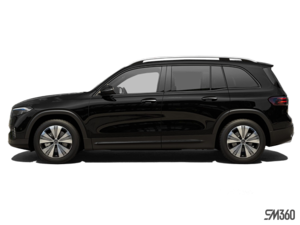5 Areas Where the 2024 Mercedes-Benz EQB Gives You More Space Than the 2025 Volvo EX30
September 11 2024,

When shopping for an electric luxury SUV, one of the key considerations is space—whether it's for passengers, cargo, or overall comfort. Both the 2024 Mercedes-Benz EQB and the 2025 Volvo EX30 are popular choices in the segment, offering luxury, advanced technology, and the benefits of electric mobility. However, when it comes to spaciousness, the EQB has a significant edge. Below, we’ll explore the five areas where the 2024 Mercedes-Benz EQB provides more space than the 2025 Volvo EX30, making it a strong contender for those who value roominess in their next vehicle.
The 2024 Mercedes-Benz EQB: A Spacious and Versatile Electric SUV
The 2024 Mercedes-Benz EQB stands out in the electric SUV market for its blend of luxury, practicality, and innovation. As part of Mercedes-Benz’s expanding EQ lineup, the EQB offers an attractive package that includes advanced technology, refined styling, and a well-appointed interior. One of its most notable features is its spacious cabin, which accommodates a variety of needs, making it ideal for families, professionals, and adventurers alike.
The EQB’s clever packaging and versatile design set it apart from many of its competitors, particularly in the compact electric SUV segment. With its available third row and generous cargo capacity, the EQB goes beyond the traditional expectations of an electric luxury SUV, offering more room where it counts the most.
- Unique Available Third Row Seating
One of the most standout features of the 2024 Mercedes-Benz EQB is its available third-row seating, a rarity in this segment. This makes the EQB one of the few compact electric SUVs capable of seating up to seven passengers, providing a level of versatility that is unmatched by the Volvo EX30, which offers seating for only five. This additional seating option is perfect for larger families or those who frequently travel with more passengers, offering flexibility that few competitors can match.
The third row in the EQB isn’t just a gimmick—it’s a genuinely useful feature that can accommodate smaller adults or children comfortably. This seating configuration enhances the EQB’s versatility, allowing owners to adapt the space to their needs, whether it’s carrying more people or folding down the seats for additional cargo space. In contrast, the EX30’s fixed five-seat layout limits its ability to cater to larger groups, making the EQB a more practical choice for those who need that extra passenger capacity.
- Front Headroom: More Space for Driver Comfort
When it comes to driver and front passenger comfort, headroom is an important factor, particularly for taller individuals. The EQB offers 1,019 mm of front headroom, which is notably more generous compared to the EX30’s 1,069 mm. This extra space means that occupants can enjoy a more comfortable driving position with less likelihood of feeling cramped.
The increased front headroom in the EQB contributes to a more open and airy cabin feel, enhancing the overall driving experience. Whether on a short commute or a long road trip, the EQB provides ample headroom that caters to a variety of body types, ensuring that all passengers can enjoy the ride without compromise. In comparison, the EX30’s tighter front headroom could be a limitation for those who prioritize comfort in the driver’s seat.
- Front Shoulder Room: More Width for Driver and Passenger
The 2024 Mercedes-Benz EQB also outshines the Volvo EX30 when it comes to front shoulder room, offering 1,455 mm compared to the EX30’s 1,400 mm. This extra width provides a greater sense of space and comfort for both the driver and front passenger, allowing for more elbow room and reducing the feeling of confinement.
This added shoulder room is especially beneficial for longer drives, where a spacious seating position can make a significant difference in overall comfort. The EQB’s wider cabin not only improves passenger comfort but also contributes to a more luxurious and premium feel inside the vehicle. In contrast, the narrower front shoulder room in the EX30 may feel more restrictive, particularly for larger passengers.
- Rear Headroom: Better Comfort for Back Seat Passengers
Rear passenger comfort is another area where the EQB excels over the EX30. The EQB offers 963 mm of rear headroom, compared to the EX30’s slightly lower 935 mm. This added space ensures that rear passengers, including taller adults, have ample head clearance and a more comfortable seating experience.
The additional rear headroom in the EQB makes it a more suitable option for families or those who frequently carry passengers in the back. It allows for a more relaxed seating posture without the need for passengers to hunch or feel confined, enhancing overall ride quality. In the EX30, the slightly lower rear headroom might not be as accommodating, particularly on longer journeys where comfort is key.
- Cargo Space: More Room for Your Gear
The EQB’s superior cargo capacity is one of its biggest advantages over the Volvo EX30. With up to 1,710 liters of cargo volume available when the second row is folded down, the EQB provides significantly more storage space compared to the EX30’s maximum of 903 liters. Even with the second row in place, the EQB offers between 496 and 1,620 liters of cargo space, while the EX30 provides just 399 liters.
This difference in cargo capacity makes the EQB far more versatile, whether it’s for daily errands, road trips, or carrying sports equipment. The ability to maximize cargo space without sacrificing passenger comfort gives the EQB a clear edge in practicality. The EX30, while still offering a functional cargo area, cannot match the EQB’s flexibility and storage options, making the Mercedes-Benz the better choice for those who prioritize spaciousness.
Space Comparison Table
|
Feature |
2024 Mercedes-Benz EQB |
2025 Volvo EX30 |
|---|---|---|
|
Third Row Seating |
Available (7 seats) |
Not available (5 seats) |
|
Front Headroom |
1,019 mm |
1,069 mm |
|
Front Shoulder Room |
1,455 mm |
1,400 mm |
|
Rear Headroom |
963 mm |
935 mm |
|
Rear Shoulder Room |
1,445 mm |
1,346 mm |
|
Cargo Volume (1st Row) |
1,620 - 1,710 L |
903 L |
|
Cargo Volume (2nd Row) |
496 - 1,620 L |
399 L |
Conclusion
When it comes to space and versatility, the 2024 Mercedes-Benz EQB clearly stands out over the 2025 Volvo EX30. From its unique third-row seating option to superior headroom, shoulder room, and cargo capacity, the EQB offers a level of practicality and comfort that’s hard to match in the electric luxury SUV segment. For those seeking an electric SUV that goes the extra mile in providing spaciousness and adaptability, the Mercedes-Benz EQB should be at the top of the list.




